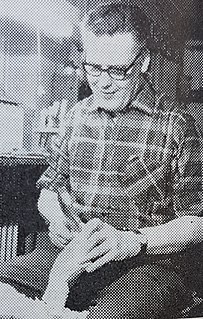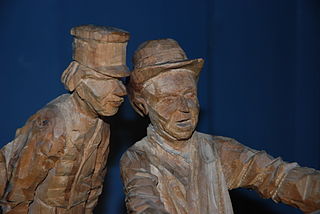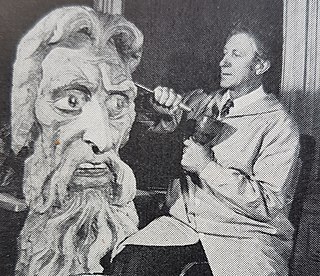
Chip carving or chip-carving, kerbschnitt in German, is a style of carving in which knives or chisels are used to remove small chips of the material from a flat surface in a single piece. The style became important in Migration Period metalwork, mainly animal style jewellery, where the faceted surfaces created caught the light to give a glinting appearance. This was very probably a transfer to metalworking of a technique already used in woodcarving, but no wooden examples have survived. Famous Anglo-Saxon examples include the jewellery from Sutton Hoo and the Tassilo Chalice, though the style originated in mainland Europe. In later British and Irish metalwork, the same style was imitated using casting, which is often called imitation chip-carving, or sometimes just chip carving, a term also sometimes applied to pottery decorated in a similar way.

Wood carving is a form of woodworking by means of a cutting tool (knife) in one hand or a chisel by two hands or with one hand on a chisel and one hand on a mallet, resulting in a wooden figure or figurine, or in the sculptural ornamentation of a wooden object. The phrase may also refer to the finished product, from individual sculptures to hand-worked mouldings composing part of a tracery.

A Dalecarlian horse or Dala horse is a traditional carved, painted wooden statue of a horse originating in the Swedish province of Dalarna (Dalecarlia). In the old days the Dalecarlian horse was mostly used as a toy for children; in modern times it has become a symbol of Dalarna, as well as of Sweden in general. Several types of Dalecarlian horses are made, with distinguishing features common to the locality of the site where they are produced. One particular style has, however, become much more common and widespread than others. It is stoutly carved and painted bright red with details and a harness in white, green, yellow and blue.

Alebrijes are brightly colored Mexican folk art sculptures of fantastical (fantasy/mythical) creatures. The first alebrijes, along with the invention of the term, originated with Mexico City cartonero Pedro Linares. Linares often told that in 1943, he fell very ill, and while he was in bed unconscious, he dreamt of a strange place resembling a forest. There, he saw trees, rocks, clouds that suddenly turned into something strange, and some kind of animals but unknown animals. He saw "a donkey with butterfly wings, a rooster with bull horns, and a lion with an eagle head", and all of them were shouting one word, "Alebrijes! Alebrijes! Alebrijes!" Before this happened, he was already a cartonero artisan. Upon recovery, he began recreating the creatures he had seen in cartonería, the making of three-dimensional sculptures with different types of papers, strips of papers and engrudo.
Carl Johan Trygg, formally Carl Johan Thrygg, also knowns as C. J. Trygg, woodcarver, was one of the recognized masters of twentieth century woodcarving, most famous for Scandinavian flat-plane style of woodcarving. Between C. J. Trygg and his sons they carved over 10,000 figures. Many of his carvings were sold to tourists for approximately $10.00 USD. Adjusted for inflation what cost $10.00 in 1929 would cost $108.05 in 2005.

Carl Olof Trygg, was one of the recognized masters of 20th century woodcarving, most famous for Scandinavian flat-plane style of woodcarving.
Harley Refsal is an internationally recognized figure carver, specializing in Scandinavian flat-plane style of woodcarving.

Axel Petersson Döderhultarn, formerly Axel Petersson, was a Swedish wood carver who was one of the recognized masters of wood carving, most famous for Scandinavian flat-plane-style woodcarving.
In 1989, a group of ten wood carvers, with the common goal of promoting the art of caricature carving, met in the back room of Paxton Lumber Co. in Fort Worth, Texas to discuss the formation of a national organization to further that goal. From that meeting came the Caricature Carvers of America (CCA). The founding group consisted of fifteen nationally recognized wood carvers representing a broad geographical distribution as well as diverse styles of caricature carving. Since the inception of the CCA, two members have resigned, four have converted their membership to "emeritus" status, three are deceased, and eighteen new members have been elected, bringing the 2003 membership to 25. The newly formed organization made no claims of being "the best," although many of the members are readily recognized as being among the elite in the carving community. The combined membership has garnered several hundred first place ribbons, including many "Best-of-Show", in carving competitions across the nation; they have published over 80 books on wood carving; and they regularly teach wood carving seminars throughout the United States and Canada.
Lars Trygg, woodcarver, was one of the recognized masters of 20th century wood carving, most famous for Scandinavian flat-plane style of woodcarving.

Herbert S. Anderson, known commonly as H. S. "Andy" Anderson, was an American woodcarver, one of the recognized masters of 20th-century woodcarving, most famous for Scandinavian flat-plane style of woodcarving and caricature carving.
Nils Trygg (1914–1951) was one of the recognized masters of twentieth century woodcarving, most famous for the Scandinavian flat-plane style of woodcarving. Nils Trygg was born in Småland, Sweden. He was one of three sons of Carl Johan Trygg and Maria Axelina Andersson. Nils worked with his father carving wooden figures of various common people in the Scandinavian flat-plane style of woodcarving. Between Nils Trygg, his father and two brothers, they carved over 10,000 figures. Many of his carvings were sold to tourists for approximately US$10. Adjusted for inflation what cost $10 in 1929 would cost $108 in 2005.

Emil Janel was a Swedish-born, American artist. A still life painter, he is mainly known for his caricatures in the Scandinavian flat-plane style of woodcarving, and is considered by many to be one of the best of this genre.

Wood carving is one of the oldest arts of humankind. Wooden spears from the Middle Paleolithic, such as the Clacton Spear, reveal how humans have engaged in utilitarian woodwork for millennia. However, given the relatively rapid rate at which wood decays in most environments, there are only isolated ancient artefacts remaining.
Andy Anderson may refer to:

Gilded woodcarving in Portugal is, along with tile, one of the country's most original and rich artistic expressions. It is usually used in the interior decoration of churches and cathedrals and of noble halls in palaces and large public buildings. An impressive collection of altarpieces are found in Portuguese churches. Originating in the Gothic era, Portuguese gilded woodcarving assumed a nationalist character during the 17th century and reached its height in the reign of King D. João V. In the 19th century it lost its originality and began to disappear with the end of the revival era.

The Döderhultarn Museum is a museum in Oskarshamn, Sweden that exhibits the carved works of Axel Petersson Döderhultarn.
Teochew woodcarving, or Chaozhou woodcarving, is a form of Chinese wood carving originating from the Tang Dynasty. It is very popular in Chaoshan, a region in the east of Guangdong. Teochew people used a great deal of Teochew wood carving in their splendid buildings.
The name Makonde art refers to East African sculptures or, less frequently, to modern paintings created by craftspeople or artists belonging to the Makonde people of northern Mozambique and southern Tanzania, separated by the Ruvuma river. Art historians, dealers and collectors have created this genre of African art, that can be subdivided into African traditional artifacts or modern artistic works. This genre can be traced back to the 1930s, when the first documented exhibition of Makonde art was held at the Centro Cultural dos Novos in Mozambique.
Ragnvald Pedersson Einbu was a Norwegian woodcarver and painter.











